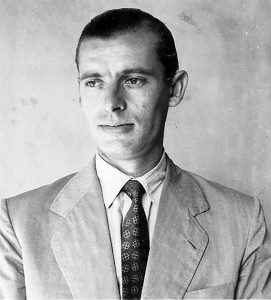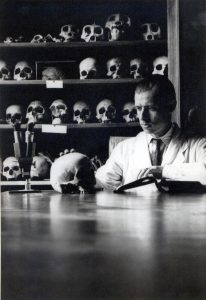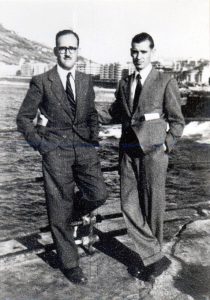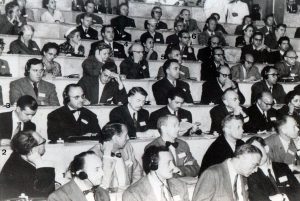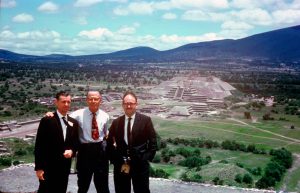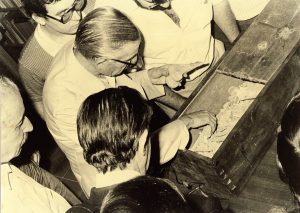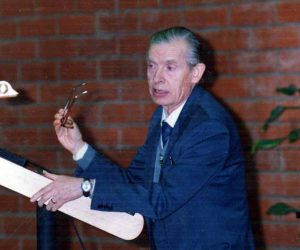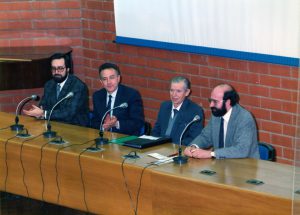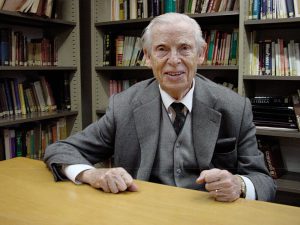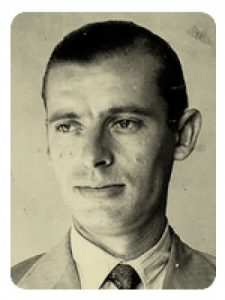
Born on the 20th September 1918, in Arbós (Tarragona), Josep Pons graduated with outstanding honours in Natural Sciences in 1942 and was awarded an Extraordinary Prize. He joined the research team headed by Professor Santiago Alcobé Noguer, Professor of Anthropology at the University of Barcelona, and completed his doctorate with outstanding honours at the University of Madrid in 1946. His teaching career began at the Faculty of Sciences at the University of Barcelona, where he became Assistant Professor of Biology and Animal Physiology (1942-1947), Associate Professor of Biology and Animal Physiology (1947-1953) and Associate Professor of Biology and Anthropology (1953-1954) (Fig. 2).
Introduction
Anthropology, the biological study of mankind, had been introduced to Spain as part of a long process at the end of the nineteenth century. In 1910, the Anthropology and Ethnography section of the National Museum of Natural Sciences in Madrid became the Anthropology Museum, and was merged with the Spanish Society of Ethnography and Pre-history. The same year, the Department of Natural Sciences at the University of Barcelona was awarded, by royal decree, Anthropology as a doctorate subject. In 1920, Don Telesforo de Aranzadi y Unamuno (1860-1945), cousin of the famed philosopher, was awarded the first Anthropology professorship at the University of Barcelona. The research projects of Professor Aranzadi, contributing to the evolution of Anthropology in general, included work on morphology, cranial theory and pre-historic and historic anthropology.
Anthropology, the biological study of mankind, had been introduced to Spain as part of a long process at the end of the nineteenth century. In 1910, the Anthropology and Ethnography section of the National Museum of Natural Sciences in Madrid became the Anthropology Museum, and was merged with the Spanish Society of Ethnography and Pre-history. The same year, the Department of Natural Sciences at the University of Barcelona was awarded, by royal decree, Anthropology as a doctorate subject. In 1920, Don Telesforo de Aranzadi y Unamuno (1860-1945), cousin of the famed philosopher, was awarded the first Anthropology professorship at the University of Barcelona. The research projects of Professor Aranzadi, contributing to the evolution of Anthropology in general, included work on morphology, cranial theory and pre-historic and historic anthropology.
Professor Aranzadi retired in 1931 and was succeeded by his disciple Don Santiago Alcobé Noguer (1903-1977). Appointed professor in 1941, he was director of the Anthropology and Genetics Research Institute of the CSIC, President of the Delegation of the institute in Barcelona, Dean of the Faculty of Sciences and Rector of the University of Barcelona. At the same time, Alcobé possessed a vast understanding of culture and a great capacity for synthesis. He extensively researched the variability of humans from a genetic perspective and emphasised the importance of genetics and statistical analysis, advancing ahead of many of his contemporaries; genetics was still not featured in Spanish programmes of study. Moreover, he directed various anthropological field trips: to the Spanish Sahara in 1942 and Equatorial Guinea in 1947. Later on, in 1958, he returned on a second trip to the High Valleys of the Pyrenees – the first had been in 1934 – on which some of his first doctoral students joined him, Drs. A. Prevosti, J. Pons, and M. Fusté.
Career
During the session on the 7th February 1941, Josep Pons was presented by Doctor Benito Fernández Riofrío to the Spanish Royal Society of Natural History and admitted as a member, as a student of Natural Sciences at the Faculty of Sciences at the University of Barcelona. He became a Life Member in the year 2000 and remained strongly linked to the RSEHN until his death.
Finishing his degree in Natural Sciences, Pons began his research into the osseous human material found during archaeological excavations of the Spanish Levante. He received a maintenance grant from the CSIC to study at the Tarragona Paleocristian Museum for the months of August in 1944 and 1945, writing his doctoral thesis on the human bone remains from the Roman period.
In the summer of 1947 he received a grant from the Pyrenees Study Institute to work as a collaborator alongside the principal researcher (Professor S. Alcobé), undertaking anthropological studies in Baztán Valley (Navarre). Later, funded by the CSIC, he studied Biostatistics and Dermatoglyphics in Rome, where he acquired excellent expertise in the fields, characterising his approach to both teaching and research (Figs. 3-4). From this experience, his interest in analysing the quantitative characters of taxonomic value in order to determine differentiation of human populations began to grow. From then on he dedicated himself intensely to the study of Dermatoglyphics, or the dermal papilla lines, which appear on fingertips and the palms of the hands. These dermal papilla lines possess the advantages of not changing with age and being definitely formed from the third month of life. It could be said that this was Pons’ true specialisation, and was what he dedicated the last years of his academic life to as Professor Emeritus. The international scientific community certainly recognised his contribution to the field, as he became President of IDA (International Dermatoglyphics Association) for ten years (1961-1971), and was voted a member of the panel to judge doctoral theses on Dermatoglyphics in Delhi (India) in 1971, 1981, 1982, 1984 and 1985.
At the same time, from 1947 until 1962 when he obtained a professorship in Anthropology at Oviedo, Josep Pons participated in the studio of human populations in the Pyrenees. This was a programme of great tradition in the anthropological school of Barcelona. An urgent piece of research, the observations of Dr. Alcobé in the Pyrenees had recorded an abrupt descent in endogamy due to the rapid increase in the mixes of immigrants, causing the genetic structure of the populations to vary considerably and rapidly; the number of individuals with four grandparents from the Aran Valley, which in 1833 was at 90%, had dropped to only 12% by 1958. Josep Pons was subsequently awarded a grant from the Wenner-Gren Foundation for Anthropological Research in New York, as a collaborator with the principal researcher (Professor S. Alcobé) in order to carry out studies on the biology of the populations of the Aran Valley throughout the months of August in 1958 and 1959. Later on, as principal researcher himself, he continued work on the studies, for which he received the Fernando el Católico Research Prize in 1962 for his work on Aragonese populations (together with Professor Miguel Fusté).
In 1962, Josep Pons obtained the professorship of Anthropology at the University of Oviedo, where he lived until 1968. His time in Oviedo were fruitful years, where he took on the post of Secretary of the Faculty of Sciences and designed the best part of the first drafts of the plans for the nascent Geology and Biology buildings – nowadays the Faculty of Geology and Mathematics – which helped the architects to have a complete idea of what was required.
From 1968 to 1973 he became professor of the Faculty of Sciences at the Complutense University of Madrid, where he took on the role of full-time Director of Department. In the Faculty of Sciences at the University of Madrid he gave theoretical and practical classes in Anthropology (1967-1973). As Head of Quantitative Anthropology (1969-1973) he applied to his university teaching what he saw clearly from the beginning of his investigative work: the analysis of the human variability is more precise and objective if bio-statistical study prevails over the simple description of variability. To this, he added what Alcobé had inculcated in his disciples: the need to ensure the presence, in the analysis of human diversity, the degree of inheritance responsible for the aforementioned diversity. Pons dedicated himself to the study of twins and the link between dermatoglyphics and other normal and pathological human characteristics, like the study of erythrocytic and haptoglobin blood groups, and the sensitivity of the taste buds to P.T.C.
Recognition
In 1973, at 55 years old and in his scientific maturity, Josep Pons returned to Barcelona as Professor, reunited with his mentor Santiago Alcobé in the Department of Anthropology on University Square in Barcelona, where they worked together for four years until Alcobé’s death in 1977. From then on until 1986, when he was affected by a law enacted by Felipe Gonzáles’ government imposing mandatory retirement on professors of a certain age, he served as Professor and Director of the Department of Anthropology in the Faculty of Biology at the University of Barcelona. After being declared retired – together with Arturo Caballero, Rector of the University of Barcelona, Antonio Prevosti and Ramón Margalef, among others – he became Emeritus Professor of the University of Barcelona for two consecutive periods, a promotion which was permitted, but, at the time, was only granted to people with great intellectual and scientific stature at the university.
The 6th June 1991 represented a professional turning point as he was delighted to be received as a full member of the Royal Academy of Sciences and Arts in Barcelona, of which Alcobé, his mentor, had been a full member and Vice-President.
Publications and international influence
Josep Pons published more than 120 publications and a large number of reviews of scientific books and articles. He occupied various positions in the CSIC of Barcelona: Grant Holder (1942-1945), Collaborator (1945-1954), Scientific Collaborator (1954-1959), and Scientific Researcher (1959-1962). In Oviedo he acted as Head of the CSIC Aggregation (1962-1968), in Madrid, Director of the Institute of Genetics and Anthropology of the CSIC (1968-1975). In addition, he was Supernumerary Professor of Research of the CSIC from 1971.
Josep Pons supervised four undergraduate theses (1972-1973) and ten doctoral theses (1972-1982). All of Professor Pons’ doctoral students later went on to be university lecturers (5) or professors (5).
His international scientific influence was remarkable considering post-war period in which he lived. He participated in a number of scientific meetings abroad, mainly in international conferences on Genetics. (Figs. 5-6).
In the First Symposium on Dermatoglyphics (Rome, 1961) he was invited to give a presentation on this academic speciality. During the symposium he was named President of the International Committee, in charge of its coordination. As President of the IDA (International Dermatoglyphics Association), he organised the Second Symposium on Dermatoglyphics (The Hague, 1963) in conjunction with the XI International Congress of Genetics. Apart from the XI International Congress of Genetics he was especially invited to participate in a meeting on Genetics and Human Behaviour organised by the University of Utrecht under the sponsorship of Wenner-Gren Foundation for Anthropological Research in New York. In addition, he acted as Secretary of the Spanish committee for the II Congress of Human Genetics (Rome, 1961) and Chair of the Spanish committee during the Permanent Council of International Conferences on Anthropological and Ethnological Sciences (1958-1964). Moreover, he participated in the International Biological Programme (IBP, 1964-74) of the International Council of Scientific Unions, in the project of Human Adaptability with the title of Anthropological and Genetic Studies in Spain, which included the themes 5: Genetic constitution and 10: Islands and isolates (Spain /HA/3.J. PONS).
Pons was President of the Spanish Biological Anthropology Society (1978-1984) and General Administrator of the University of Oviedo (1966-1968). Associated member of Current Anthropology of the Wenner-Gren Foundation for Anthropological Research in New York (USA) in 1958. In addition, he belonged to other scientific societies such as the European Anthropological Association, the Deutsche Gesellschaft für Anthropologie and the Catalan Society of Biology. Between his achievements in research, and on the Santiago Ramón y Cajal Board of Trustees for the CSIC, Professor Pons acted as Chair of the Board of Governors (1968-1973), Co-Advisor (1969-1972) and Advisor (from 1972). He was also Director of the magazine Trabajos de Antropología (1970-86).
On the 6th and 7th of June 1982, at the request of the President of the Catalan Parliament and historian, D. Miquel Coll Alentorn, Pons examined, as an academic expert, the remains of Guifré el Pelòs (Wilfred the Hairy) in the Benedictine Monastery of Santa María de Ripoll in the Catalan province of Girona, founded by Wilfred himself in the year 880 A.D. After opening the ancient wooden chest which contained the bones of this iconic historical figure who initiated the Barcelona dynasty of Catalonia, in the face of the civic authorities, priests of Ripoll and official notaries (Fig. 7), Pons discovered that inside were three ankle bones from different feet, meaning that without a doubt, the remains belonged to at least three individuals. The author, an eyewitness to the scene, hugely admired the delicacy and prudence with which Professor Pons led the non-experts present to look at the evidence and come to a logical deduction. The information was then placed on the notarial deed, before the wooden chest proceeded to be closed once again.
Tribute
On the 23rd of March 1987, the Faculty of Biology and the Catalan Society of Biology awarded him with a just and fitting tribute for his retirement. The event included a lecture by the UCM Professor Arturo Valls Medina, on the “Genetic Analysis of Kinship in Anthropology” (Figs. 8-9). The tribute highlighted Professor Pons’ pioneering work on anthropological activity at the universities of Oviedo and the Complutense in Madrid, and the quality of his faculty, both in teaching and research – the result of great professional preparation and complete dedication. As for the department’s collaborators and cooperative atmosphere, the tribute celebrated its great openness and liberty of thought, not only for its scientific arguments but also for the collaboration alongside those with very different ways of thinking and acting at a time of deep political changes. Pons was noted for his sense of justice and tolerance, meticulous work ethic, his spirit of conciliation, cordiality and simplicity. The tribute received support from numerous international organisations.
Farewell
Professor Josep Pons possessed the innate qualities of a teacher and communicator, able to make difficult concepts easy without distorting them. Not easy for those of us who try to emulate him. He enjoyed permanent popularity among students for his personal charm and friendliness, his everlasting smile, cordial and humble, aware that that is what brings people together.
Time and tide wait for no man, wrote Sir Walter Scott. The last phase of Josep Pons was like a languid sunset (Fig. 10). Despite of its inevitable ending, he has not left us. Because he has left us everything from the exemplary career of his personal and academic life, and in his scientific work.
On the 28th July 2013, at 94 years old, Josep Pons died in Sant Feliu de Llobregat (Barcelona).
Acknowledgements
This biography was written by Daniel Turbón, Professor of Physical Anthropology at the Faculty of Biology at Barcelona and friend of Josep Pons Rosell.

